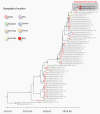The first two cases of 2019-nCoV in Italy: Where they come from?
- PMID: 32022275
- PMCID: PMC7166327
- DOI: 10.1002/jmv.25699
The first two cases of 2019-nCoV in Italy: Where they come from?
Abstract
A novel Coronavirus, 2019-nCoV, has been identified as the causal pathogen of an ongoing epidemic, with the first cases reported in Wuhan, China, last December 2019, and has since spread to other countries worldwide, included Europe and very recently Italy. In this short report, phylogenetic reconstruction was used to better understand the transmission dynamics of the virus from its first introduction in China focusing on the more recent evidence of infection in a couple of Chinese tourists arrived in Italy on 23rd January 2020 and labeled as Coronavirus Italian cases. A maximum clade credibility tree has been built using a dataset of 54 genome sequences of 2019-nCoV plus two closely related bat strains (SARS-like CoV) available in GenBank. Bayesian time-scaled phylogenetic analysis was implemented in BEAST 1.10.4. The Bayesian phylogenetic reconstruction showed that 2019-2020 nCoV firstly introduced in Wuhan on 25 November 2019, started epidemic transmission reaching many countries worldwide, including Europe and Italy where the two strains isolated dated back 19 January 2020, the same that the Chinese tourists arrived in Italy. Strains isolated outside China were intermixed with strains isolated in China as evidence of likely imported cases in Rome, Italy, and Europe, as well. In conclusion, this report suggests that further spread of 2019-nCoV epidemic was supported by human mobility and that quarantine of suspected or diagnosed cases is useful to prevent further transmission. Viral genome phylogenetic analysis represents a useful tool for the evaluation of transmission dynamics and preventive action.
Keywords: engineering and technology; epidemiology; infection; macromolecular design.
© 2020 Wiley Periodicals, Inc.
Figures

Comment in
-
An integrated response to the impact of coronavirus outbreak on the Emergency Medical Services of Emilia Romagna.Resuscitation. 2020 Jun;151:1-2. doi: 10.1016/j.resuscitation.2020.03.005. Epub 2020 Mar 20. Resuscitation. 2020. PMID: 32205158 Free PMC article. No abstract available.
-
About the origin of the first two Sars-CoV-2 infections in Italy: Inference not supported by appropriate sequence analysis.J Med Virol. 2020 Sep;92(9):1404-1405. doi: 10.1002/jmv.25833. Epub 2020 Apr 19. J Med Virol. 2020. PMID: 32249944 No abstract available.
References
MeSH terms
LinkOut - more resources
Full Text Sources
Miscellaneous

